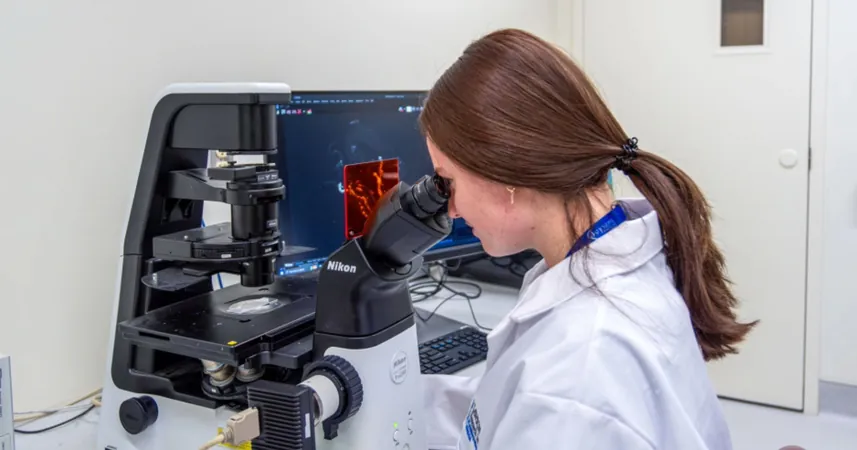
Biomedical Breakthrough: How Fruit Flies Could Lead to New Kidney Stone Treatments
2025-03-25
Author: Emily
Deep within the buzzing heart of the Microbiome and Probiotic Research Lab at St. Joseph’s Hospital lies a peculiar setting that many might overlook — the fly room. This unassuming space is home to groups of tiny fruit flies that, while often dismissed as mere pests, are actually at the forefront of groundbreaking research that could reveal the surprising connection between antibiotic use and the rising incidence of kidney stones.
Kidney stones are not a trivial issue; they are increasingly common, affecting many, especially women and young children. Current research spearheaded by the Schulich School of Medicine & Dentistry in collaboration with St. Joseph’s Health Care London’s Lawson Research Institute is attempting to uncover whether the widespread use of antibiotics is a hidden factor contributing to this painful condition. Previous studies have indicated that individuals suffering from kidney stones often experience a disruption in their gut microbiome alongside certain genetic markers that may indicate antibiotic resistance.
Graduate student Riley Fidler is leading the charge in this frontier of research. Her central question: Does antibiotic use disrupt the delicate balance of the microbiome, thus elevating the risk of kidney stone development in otherwise healthy individuals? The answer may lie within the genetic similarities between humans and fruit flies, which share around 70% of our DNA. This remarkable connection allows scientists to use these tiny insects as proxies to study human diseases effectively.
The research is intricate and painstaking. Fidler meticulously places various populations of fruit flies in different antibiotic environments to gauge the impact on their health. These flies possess excretory organs known as Malpighian tubules — diminutive structures that serve a function akin to the nephrons in human kidneys. Strikingly, the "kidney stones" that form within these tubules are smaller than grains of salt, highlighting the advanced methods required to analyze them.
Using birefringence microscopy, a sophisticated technique that enables the visualization of microscopic formations, Fidler examines the minuscule kidney stones generated by the antibiotic-treated flies. She can quantify the results using computer software, providing crucial data on how various antibiotics — including cefazolin, ciprofloxacin, penicillin, and sulfamethoxazole-trimethoprim — influence kidney stone formation.
The implications of this research are staggering. If a link between antibiotic use and kidney stone formation can be firmly established, it may lead to improved antibiotic stewardship, reducing unnecessary prescriptions and facilitating the development of targeted treatments. This is particularly pressing for pediatric patients, as proper guidance could prevent their early exposure to antibiotics that might contribute to kidney stone risk.
Fidler's work is further enriched by her collaboration with experienced urologists and clinicians at St. Joseph's, ensuring that the research addresses real-world challenges faced by patients. This robust clinical connection not only informs her lab experiments but also extends the potential impact of her findings on patient care and quality of life.
“I thrive on the stories the research tells,” Fidler says, capturing the essence of scientific inquiry. “Every result shapes the next step, and it's that passion for discovery that drives us to tackle these challenges.” As research continues and our understanding of the microbiome deepens, the potential for medical advancements to improve the lives of millions remains bright.









 Brasil (PT)
Brasil (PT)
 Canada (EN)
Canada (EN)
 Chile (ES)
Chile (ES)
 Česko (CS)
Česko (CS)
 대한민국 (KO)
대한민국 (KO)
 España (ES)
España (ES)
 France (FR)
France (FR)
 Hong Kong (EN)
Hong Kong (EN)
 Italia (IT)
Italia (IT)
 日本 (JA)
日本 (JA)
 Magyarország (HU)
Magyarország (HU)
 Norge (NO)
Norge (NO)
 Polska (PL)
Polska (PL)
 Schweiz (DE)
Schweiz (DE)
 Singapore (EN)
Singapore (EN)
 Sverige (SV)
Sverige (SV)
 Suomi (FI)
Suomi (FI)
 Türkiye (TR)
Türkiye (TR)
 الإمارات العربية المتحدة (AR)
الإمارات العربية المتحدة (AR)